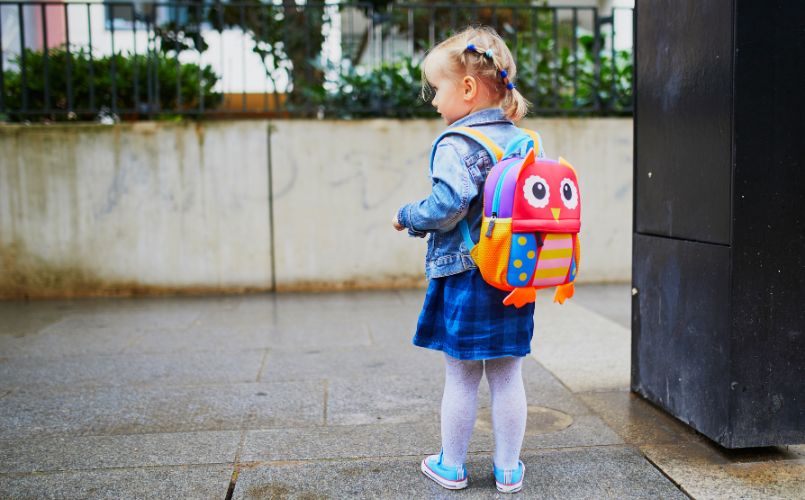Starting a new school
The commencement of school life is not merely an academic beginning but a significant emotional and social leap. These are the times when children encounter a mosaic of new relationships, responsibilities, and routines. The complexity of this transition is echoed in a study by the National Scientific Council on the Developing Child (2007), which underscores the profound impact of early school experiences on a child’s developmental trajectory.
A pivotal aspect of this transition lies in navigating social dynamics. Children find themselves amidst peers from diverse backgrounds with each child bringing their unique experiences and personalities. This diversity, while being enriching, can also be a source of anxiety for some. It’s not uncommon for children to grapple with feelings of uncertainty and a yearning for the security of their pre-school environment.
Parents and educators play an indispensable role in mitigating these challenges. A study highlights the importance of establishing a nurturing and responsive school environment that acknowledges and addresses children’s emotional needs by encouraging open communication, fostering a sense of belonging, and gently guiding children in forming new friendships they are taking critical steps in this new milestone.
This transition to school also introduces a new spectrum of learning experiences and cognitive demands. Here, the emphasis on a supportive learning atmosphere becomes paramount. Research in early childhood transitions indicates that children who perceive their school environment as encouraging and inclusive exhibit greater academic engagement and resilience.
Childhood Transitions of Welcoming a New Sibling:
The arrival of a new sibling can be a transformative experience for a child, introducing a profound shift in the family landscape. This change can evoke a spectrum of emotions, from joy and curiosity to apprehension and jealousy. Navigating this transition requires empathy and understanding, as children adapt to a new role and redefined family dynamics.
The introduction of a new sibling often challenges a child’s sense of security and belonging during this phase many children experience feelings of displacement and rivalry, which can manifest in behavioral changes. These emotions are natural and reflective of the child’s process of adjusting to a shared parental attention landscape.
Parents play an instrumental role in easing this transition with open communication, offering children a safe space to express their feelings and concerns while prioritizing one-on-one time with the older child, even amidst the demands of caring for a newborn, is crucial in affirming their importance in the family.
Moreover, involving the older child in the care of the new sibling can foster a sense of responsibility and inclusion. This approach suggests that such involvement can enhance the sibling bond and mitigate feelings of jealousy.
The role of extended family and community is also significant. Grandparents, relatives, and close friends can provide additional emotional support and attention, helping the older child feel valued and loved.
The arrival of a new sibling is an opportunity for growth and development. With thoughtful guidance and support, children can navigate this transition, embracing their new role and forming lasting bonds. The key lies in acknowledging and addressing their emotional needs, ensuring that they feel secure and valued in their evolving family constellation.
Childhood Transitions of Moving to a New Home

Relocating to a new home signifies a significant transition for a child, encompassing not just a change of physical space, but also an adjustment to a new social and cultural environment. This shift can be both exhilarating and daunting, as children bid farewell to familiar surroundings and relationships to embrace the unknown.
The impact of moving on children is profound and multifaceted, frequent moves can be associated with social and academic challenges. However, the manner in which families navigate this transition can significantly influence its outcome.
Key strategies to facilitate a positive moving experience include:
Open Communication: Prioritize discussions about the move. Encourage children to share their feelings and concerns, offering reassurance and empathy.
Involvement in the Process: Involve children in decisions where possible, such as selecting their new room or exploring new schools. This involvement can provide a sense of control and ownership over the change.
Maintaining Familiar Routines: Preserve familiar routines to provide continuity and stability. Consistent bedtime rituals or mealtime traditions can offer comfort amidst change.
Social Connections: Foster opportunities for new friendships while maintaining old connections. Arranging playdates or enrolling in local activities can facilitate social integration.
School Transition Support: Collaborate with the new school to ensure a smooth transition. Familiarize children with the school environment and staff beforehand.
The role of parents in this transition is critical, parents can transform the moving experience into a journey of growth and discovery. By addressing the child’s emotional and social needs, parents can lay the foundation for a positive adjustment to their new home and community.
Moving to a new home, while challenging, presents a unique opportunity for children to develop adaptability, resilience, and new social skills. With thoughtful preparation and support, this transition can be navigated successfully, paving the way for new adventures and learning experiences.
Handling Family Challenges

Family challenges, such as parental separation or the loss of a loved one, represent profound and often distressing transitions for children. Navigating these changes requires sensitivity, open communication, and the provision of stable, loving support.
Parental separation can be particularly unsettling for children, as it alters the foundational structure of their family life. According to a study by Hetherington and Kelly (2002), children may experience a range of emotions, including confusion, guilt, and sadness. It is crucial for parents to assure children that these changes are not their fault and that both parents will continue to love and support them.
Key considerations during family transitions include:
Consistency and Routine: Maintaining a consistent routine helps provide a sense of normalcy and security. Regular schedules for meals, school, and activities can offer stability.
Open and Age-Appropriate Communication: Discuss the changes in a way that is understandable and reassuring for the child’s age and maturity level. Avoid burdening them with adult concerns.
Emotional Support and Validation: Acknowledge and validate the child’s feelings. Encourage them to express their emotions and provide comfort.
Professional Support if Needed: Consider seeking support from counselors or therapists, especially in cases of intense emotional distress.
In the case of a family bereavement, the challenge is to help children understand and cope with loss. Grieving is a personal process, and children may exhibit a wide range of responses. Creating a space for them to grieve and remember the loved one is important. Activities like sharing stories, looking at photos, or creating a memory box can be helpful.
The common thread in successfully navigating these transitions is the role of the parent or guardian. It is through your understanding, patience, and proactive support that children learn to adapt to changes. Your guidance is the beacon that helps them steer through these uncharted waters with confidence.
We must remember, the goal is not to shield children from the challenges of change but to equip them with the skills to face and embrace these changes. These early childhood transitions are a journey in itself, a chapter in the larger story of a child’s growth. As parents and guardians, your role is crucial in scripting these chapters, ensuring they are filled with learning, love, and a sense of security. Embrace these transitions, for they are the stepping stones in your child’s journey of becoming a well-rounded, resilient individual.
Navigating Childhood Transitions
As we have explored, childhood transitions, whether starting school, welcoming a new sibling, moving homes, or facing family challenges, are pivotal moments in a child’s life. These experiences, while potentially daunting, offer invaluable opportunities for growth, learning, and emotional development.
The common thread in successfully navigating these transitions is the role of the parent or guardian. It is through your understanding, patience, and proactive support that children learn to adapt to changes. Your guidance is the beacon that helps them steer through these uncharted waters with confidence.
Remember, the goal is not to shield children from the challenges of change but to equip them with the skills to face and embrace these changes. By doing so, you are not only aiding them in the immediate transition but also laying the groundwork for their future resilience and adaptability.
Each transition is a journey in itself, a chapter in the larger story of a child’s growth. As parents and guardians, your role is crucial in scripting these chapters, ensuring they are filled with learning, love, and a sense of security. Embrace these transitions, for they are the stepping stones in your child’s journey of becoming a well-rounded, resilient individual.




